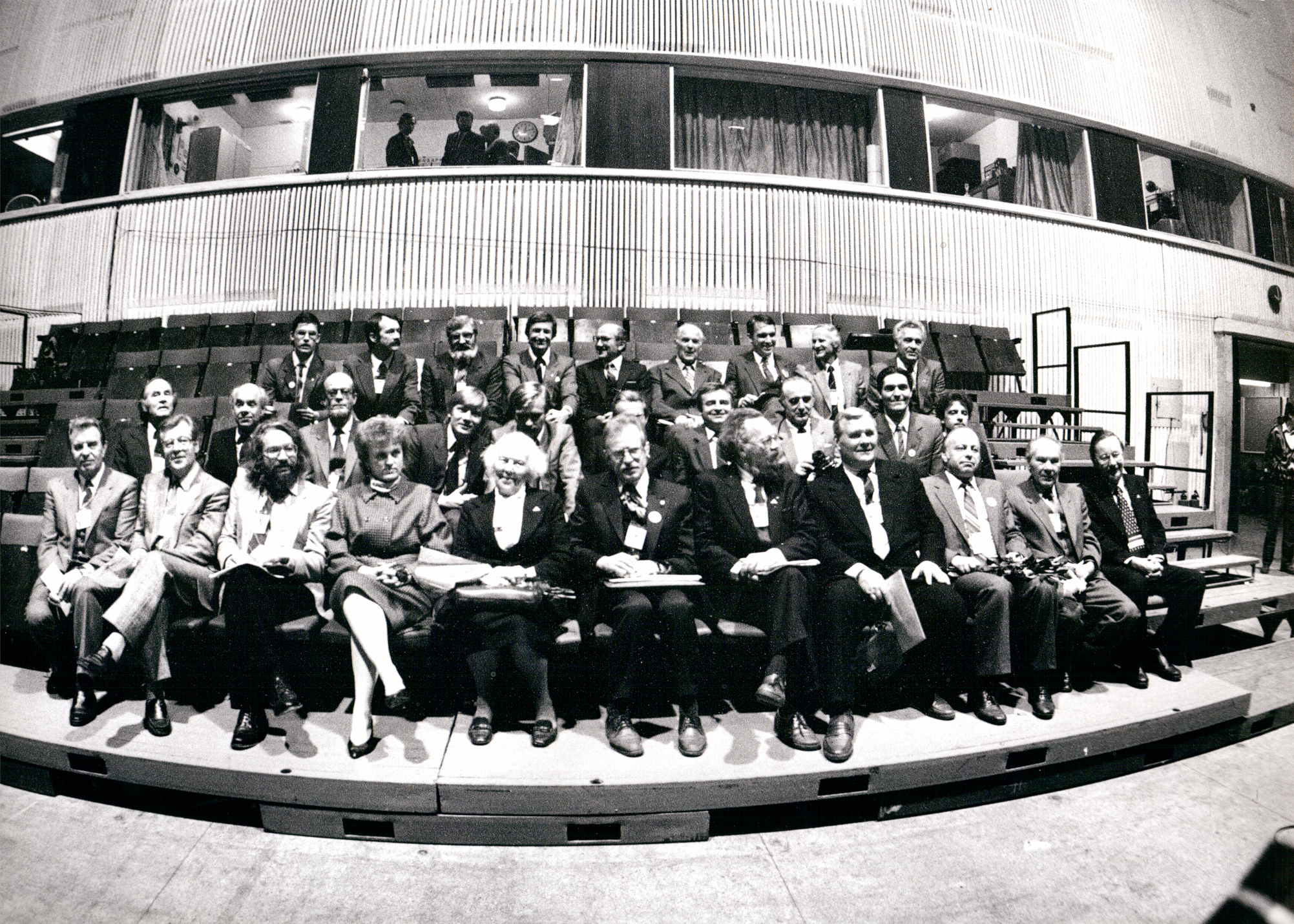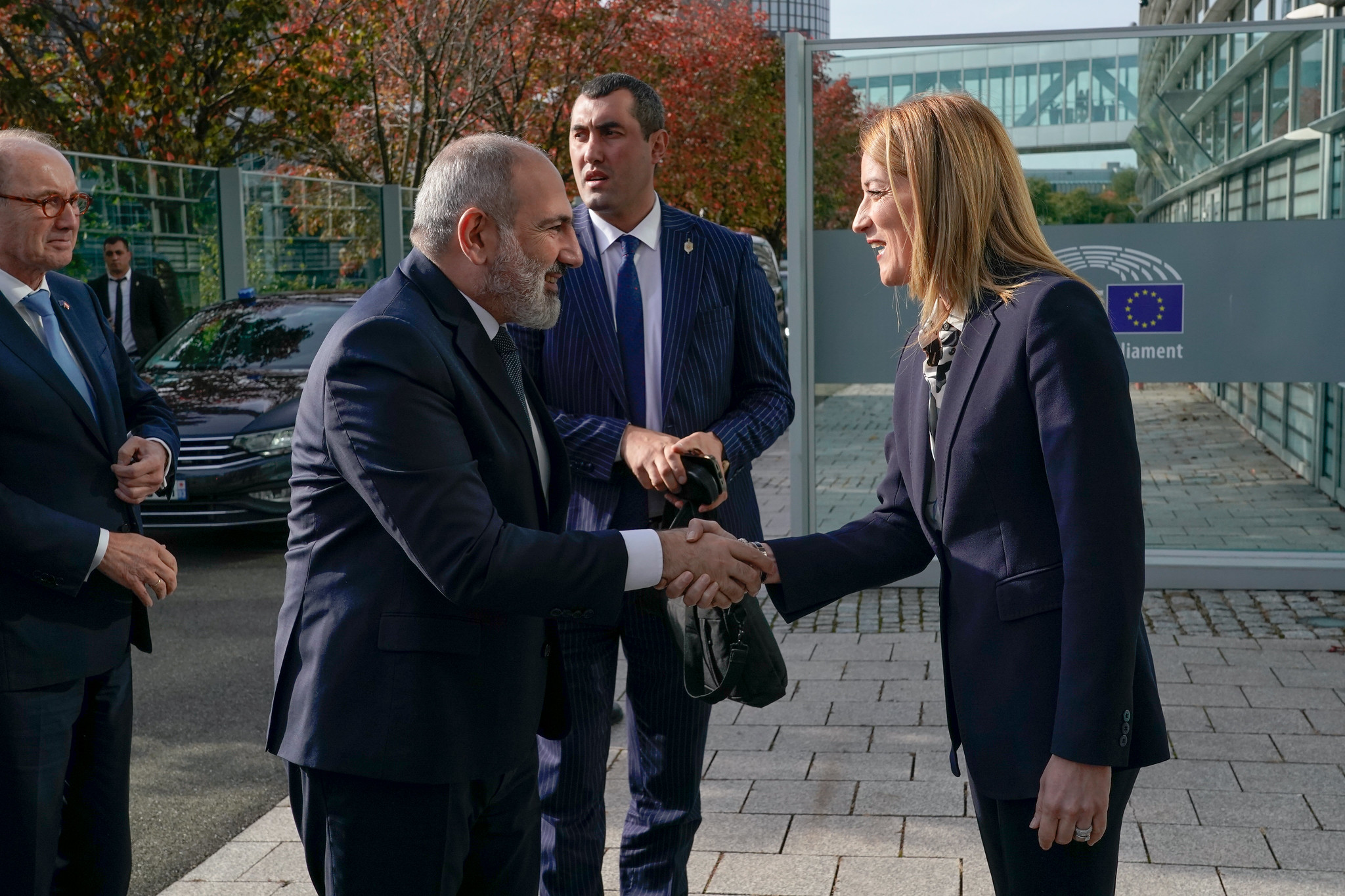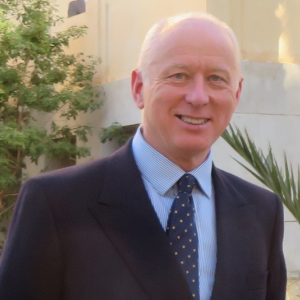Escaping from Russia: Baltic playbook for the South Caucasus
Amid a geopolitical landscape marked by shifting dynamics, Armenia and the wider South Caucasus region find itself standing at a critical crossroads. As Armenian Prime Minister Nikol Pashinyan recently signalled a shift away from Moscow’s grip, parallels emerge with the Baltic countries’ road towards less Russian influence. Former head of the OSCE Mat Whatley explains how the Baltic playbook could offer a roadmap for Armenia’s escape from Russia’s grip.
During a speech in Hamburg in early 1994, the president of newly independent Estonia criticised Russia’s foreign minister for suggesting that its troops should stay in former USSR states. The tone of his anti-imperialist speech riled a little-known St. Petersburg official in attendance, named Vladimir Putin, who would storm out of the banqueting hall in protest.1 Still, Moscow’s military had withdrawn by summer.
Three decades later, Armenia is singing the same tune in the South Caucasus – albeit sotto voce. In October 2023, Prime Minister Nikol Pashinyan declared there was no advantage for his country in continuing to host Russian military bases; Armenia needed to diversify its security alliances from its former overlord.2 The shift would mark a profound erosion of Pax Russica in the South Caucasus (Armenia, Azerbaijan and Georgia), reconfiguring alliances in the region and isolating Moscow globally.
To bridge rhetoric to reality, Armenia must prioritise making peace with its neighbour Azerbaijan over Nagorno-Karabakh
To achieve this, Armenia and the wider South Caucasus region should draw inspiration from the strategies already employed by the Baltic countries and take a page out of their playbook. Upon gaining independence from the USSR, the Baltic countries were near-totally dependent on Russia, which compromised the sovereignty of each nation. However, today they are amongst the staunchest defenders of Russia’s adversary, Ukraine.
This shift first and foremost required local political will and leadership to pivot the Baltic region towards Europe. Secondly, regional integration that facilitated trade with the West played an important role in steering their economies away from dependence on Russia. Thirdly, Western support provided crucial sustenance to the movements that first challenged Soviet rule; later, continued investment helped gear economies towards the West. A similar mix will be needed in Armenia to dilute Russian influence.
Bridging rhetoric to reality
Prior to answering how Armenia could rid itself of Russian influence, it is important to discuss why the country would want to in the first place. Out of the South Caucasus nations, Russia is most deeply entrenched in Armenia. As the Soviet Union collapsed, war erupted over the Armenian-majority province of Nagorno-Karabakh within Azerbaijan. Following a Russian mediated ceasefire, Armenia was left in control of the territory in 1994 – with Russia as its security patron.
To bridge rhetoric to reality, Armenia must prioritise making peace with its neighbour Azerbaijan over Nagorno-Karabakh. Both Azerbaijan and its ally Turkey have closed their borders to the country. Only trade with Russia to its north (through Georgia) and with Iran to its south (through difficult mountainous territory) has remained, entrenching Armenia’s economic and energy dependence on Russia.3 Russia instrumentalised this conflict – similar to those in Abkhazia and South Ossetia in Georgia – to project power in the region.
In 2021, the long-standing Nagorno-Karabakh conflict turned hot. Azerbaijan captured some of the territories previously held by Armenia, prompting Russia to step in to broker another ceasefire. However, in September 2023, Azerbaijan took back the remainder of its land in a swift 24-hour military operation. With the facts changed on the ground, Armenia has agreed to recognise – like the rest of the world – that Karabakh is Azerbaijan’s sovereign territory. This recognition represented a significant shift, as the issue had previously presented a major obstacle to efforts to resolve the conflict.
Yet, Armenia also acknowledged that it could not rely on Moscow for security. Instead, the country realised the necessity of striking peace with its foe, Azerbaijan. At the end of October 2023, Prime Minister Pashinyan unveiled his ‘Crossroads of Peace’ initiative. The proposal aimed to restore open borders, communication networks and transport links. It bore resemblance to proposals from Baku, such as the so-called ‘Zangezur corridor’, which sought to connect the nations and reintegrate the region. The countries’ position on a settlement has never been closer, offering a real prospect of expunging Russian influence from the South Caucasus.
To rid itself of Russia’s influence once and for all, Armenia should draw inspiration from the Baltic playbook.
The Baltic playbook: Political will
The first step of the Baltic playbook emphasises the importance of political will. In the Baltics, pro-liberal movements such as the Sajudis in Lithuania mobilised against Soviet rule. Following independence, the group’s leaders articulated a ‘Return-to-Europe’ strategy to rally public support and build institutions around.
Sajudis was not alone in the Baltic region; there was more than some coordination between similar non-communist political movements in Estonia and Latvia. This collaboration culminated in 1989 in a three-country act of peaceful protest known as the ‘Baltic Way’.4 Approximately two million citizens across the three nations joined hands in an unbroken human chain spanning over 600 kilometres, linking the capital cities of Vilnius, Tallinn and Riga. Although orchestrated by non-state actors, this was an act of extreme political will.
Likewise, political will from in this case the governmental leaders in both Armenia and Azerbaijan will be critical for signing a peace deal, without which economic integration will become improbable. The countries’ renewed independence was forged amid conflict with each another, with Nagorno-Karabakh shaping their post-USSR identities and perpetuating mutual perceptions ever since. Overcoming deeply ingrained enmity and mistrust demands strong leadership.

For securing a peace deal, Pashinyan must first confront domestic critics. In the past, he has u-turned under mounting pressure.5 The primary challenge will arise from the nationalist opposition: a potpourri of Moscow-backed warlords from the first Karabakh war who had retained political power in Armenia since 1998 until they were initially defeated by Pashinyan through street protests and later in the 2018 general election. Russia may help them with its hybrid warfare arsenal to fuel grievances. In response, Pashinyan must mobilise other constituencies around his peace agenda, particularly the Western-orientated youth who toppled the Karabakh-clan in the 2018 Velvet Revolution that brought him to power.
The Azerbaijani leadership must also show political will. Past rhetoric, rooted in grievances over occupation, has hindered trust-building between Azerbaijanis and Armenians. However, since the military operation in September, the tone seems to be changing into one of reconciliation and co-habitation in Karabakh, providing a more fertile ground for discussions. Practical plans for the reintegration of the 100,000 Karabakh Armenians who fled in September should follow.6
The establishment of an Azerbaijan-established online portal for them to register for returning home marks an important first step.7
The Baltic playbook: Economic divergence
The Baltic playbook also underscores the significance of economic divergence. As small states, the Baltics recognised they needed each other at independence, exemplified by signing the Declaration of Unity and Cooperation in 1990. Moving from a highly centralised system in which Moscow mediated any inter-economic cooperation, they inked a Baltic-wide free trade agreement in 1994. Coupled with a pivot to Europe, this agreement economically interconnected the countries, facilitating trade between them and beyond to Europe. This gave the region an economic alternative to reliance on Russia.
Similarly, the South Caucasus sits at a critical intercontinental trade juncture, serving as the only overland freight route from East Asia to Europe that does not pass through Russia or Iran. Yet, insecurity has long undermined its appeal. While some regional infrastructure linking the region to Europe and Central Asia has been developed, the Nagorno-Karabakh conflict has diverted it away from Armenia, isolating the country from regional integration and allowing Azerbaijan and Georgia to taper their dependence on Russia.
There has never been a better opportunity to follow a similar path.
For instance, the construction of the Baku-Tbilisi-Ceyhan (Azerbaijan-Georgia-Turkey) oil pipeline in 2003 reduced Azerbaijan’s reliance on Russia for exporting energy to Europe. This safeguarded the country’s critical economic assets from manipulation by Moscow to exert pressure on government policy, whilst significantly bolstering revenue generation. Georgia gained an alternative source of energy to Russian imports and earned transit fees from the oil flowing to Turkey and Europe. Later, gas and train freight lines built along the same route further enabled the nations to become more self-sufficient.
Peace opens the possibility to establish energy and electricity connections with Armenia, weaning Azerbaijan from one of its most compromising reliances on Russia. Moreover, shared infrastructure and transportation links – as outlined in President Ilham Aliyev’s Zangezur corridor and Pashinyan’s Crossroads of Peace – would connect the country not only to the region but also to the wider world. Through Azerbaijan the doors open to Central Asia and through Turkey those to Europe.8 As the South Caucasus nations grow stronger together, Russia’s influence will diminish.

The Baltic playbook: The role of the West
Finally, the Baltic playbook stresses the role of the West. Throughout the 80s and early 90s, Western funds flowed to pro-liberal movements – like the Sajudis in Lithuania – that opposed Soviet domination. They sought to leverage these movements to bring about change by bolstering the home-grown groundswell in all three Baltic states for a non-communist, Western-orientated future. Following independence, the West continued to follow through, clearing the path for Baltic membership of the EU and NATO that would bring investment, stimulate economies and anchor security, diluting Russia influence in their countries.
Similarly, the West must adopt a two-pronged approach in the South Caucasus. First, it must ensure the successful implementation of a peace deal. In the past, Western powers have offered themselves as mediators in this conflict,9 but this role was undermined – beginning in late 2023, when EU-led mediation seemed to be progressing most positively – by French President Emmanuel Macron taking an openly pro-Armenian position to appeal to the large domestic diaspora population.10
Since then, the relationship between France and Azerbaijan has deteriorated severely, with France selling missile weapons systems and armoured vehicles to Yerevan,11 and Azerbaijan accusing a French citizen in Baku of spying as well expelling two French diplomats.12 With France having effectively isolated itself from the negotiations, other Western powers have stepped in. Germany in particular has positioned itself as a more “honest” broker, following a tour of the region by Foreign Minister Annalena Baerbock late last year.13
France’s diplomatic bias has also had the unintended side effect of bringing the leaderships of Azerbaijan and Armenia together without any international mediation – whether Western or otherwise. Most unexpectedly, in December 2023, Armenia supported Azerbaijan’s bid to host COP29, marking a significant shift from its previous stance of outright vetoing any Azerbaijani proposal. The announcement of this breakthrough was made simultaneously by the administrations of both the Azerbaijani president14 and Armenian prime minister15 , and it also included an agreement for a prisoner exchange.
This is clear and immensely welcome progress. However, it should not imply that there is less of a role now for Western powers. On the contrary, it emphasises the need for these powers to exert maximum effort to present themselves as honest brokers, thereby maintaining some influence over talks and keeping leaders in Armenia and Azerbaijan committed to reaching an agreement.
Beyond achieving a peace deal on paper, the West must engage, collaborate, and invest in the region to facilitate regional integration, consolidate peace and diminish Russian influence. This approach will not only isolate Russia on the global stage but it will also bring stability to a volatile region critical for the transit of Caspian energy supplies and East-West trade.
None of this will be easy. Neither was the Baltics’ journey from Moscow’s grip, which has seen every form of interference – from cyberattacks to social media trolling and Russian sponsorship of politicians – and included the difficult disconnection from older economic and energy ties with the East to pivot towards West. But they showed it was possible. In the South Caucasus, there has never been a better opportunity to follow a similar path.
- 1The Economist, ‘How the Baltic states resist Russia’, 2 February 2019.
- 2Yaroslav Trofimov, ‘Armenia Seeks Western Support as Relations With Russia Deteriorate’, The Wall Street Journal, 25 October 2023.
- 3Structural dependence on Moscow for its energy, economy and defense has compromised Armenia’s sovereignty. In 2013, it had to join the Eurasian Economic Union, Russia’s customs union, at the expense of an Association Agreement it had been working towards with Brussels. More recently, Armenia has been forced to play sanctions buster, as it imports then re-exports goods Russia can no longer access on the open market.
- 4‘The Baltic Way: How Holding Hands Changed History’, Lithuania.lt, 22 August 2023.
- 5When Pashinyan announced he would recognise Karabakh as Azerbaijan as part of a peace deal after the 2020 war, he was decried as a traitor. In response, he changed his position to a Russian proposal to take Karabakh’s reintegration into Azerbaijan off the table in negotiations. This would have only elongated irresolution to Russia’s benefit.
- 6Andrew Osborn, ‘Azerbaijan says it does not want exodus from Nagorno-Karabakh, urges Armenians to stay’, Reuters, 28 September 2023.
- 7During the September offensive, most of Karabakh’s population of 100,000 fled over the border to Armenia.
- 8Ankara, Baku’s ally, has stated it will open its borders to Armenia once a peace deal is in place with Azerbaijan.
- 9Previous mediation efforts through the Minsk group – led by the US, France and Russia – failed due to the chasm that separated the positions of both Armenia and Azerbaijan. An impasse calcified. Western mediators failed to recognise the group’s redundancy: the absence of a meaningful path to a negotiated resolution only raised the prospect of force to settle the dispute.
- 10Macron has made his support for Armenia unequivocal, and the French parliament have called for sanctions against Azerbaijan. Consequently, his involvement has been counterproductive. Azerbaijan has cancelled multiple EU-mediated meetings once Paris’ attendance has been confirmed.
- 11‘France to boost Armenia's air defences with radars, missiles – minister’, Reuters, 23 October 2023.
- 12Nicolas Camut, ‘Azerbaijan arrests French national for espionage’, Politico, 9 January 2024.
- 13‘German FM calls for new Armenia-Azerbaijan peace talks’, Deutsche Welle, 11 March 2023.
- 14The Azerbaijan State News Agency, ‘Joint Statement of the presidential administration of the Republic of Azerbaijan and the office of the prime minister of the Republic of Armenia’, 7 December 2023.
- 15The Prime Minister of the Republic of Armenia, Joint statement of the Office of the Prime Minister of the Republic of Armenia and the Presidential Administration of the Republic of Azerbaijan, 7 December 2023.





1 Comments
Load comments
A very biased narrative, leaving out several fundamenta....
The article is a Baku narrative as it leaves out important facts. Too much blaha blaha western democracy.
1. Azerbaijan is not a reliable partner to sign a peace agreements with because it has one of the worst human rights records in the world.
It is pursuing panturanism, which is the last remaining outright fascism on the planet, i.e. "Turken ueber alles" policy. The turkish+Azerbaijan duo will not stop short of pursuing conquest and elimination of Armenia proper, as the Armenian Genocide already showed their pan-turanic ideology. Armenian Genocide denial of the duo cannot be separated from their non-peace committment w.r.t. armenians.
2. How can Nagorno-Karabakh people feel safe under pan-turanic ideology without military guarantees from the west? Not even azeris are free to tell their opinions, nor are peoples of turkey. The so called west is in that sense as disingenious and treacherous as Russians power in Armenia. The west has not curbed and will not even try to curb the the turkey+israel's military support and outright direct boots-on-the-soil support to Azerbaijan. This is something in their power, but havenot. They will just leave armenians alone (even less support than to Ukraine). They have done so in cyprus, and they have just watched 120'000 indigenious inhabitants of nagorno-karabakh to suffer azerbaijan's blockade during 10 months, only to look the other way when they left their lands home to them since 3 millenia. No, Artsakh was not inhabited nor controlled by Azerbaijan up until their 2023 invasion. They were left completely alone in the hands of a modern day Cenghis Khans: Aliyev on one side Erdogan+Netanyahu on the other. The west had and has leverage on Erdogan+Netanyahu but has not used it deliberately.
3. Mr. Aliyev is in fact a staunch aly of Erdogan+Putin. The west has no influence on him, because he sells russian gas and oil via turkish territory . The oil is washed white, if need be, by Erdogan+Netanyahu help and resold. A large chunk of Aliyev's incomes is from commission he gets from this brokerage. His dictatorship is protected by Mr. Putin and Mr. Netanyahu unholy aliance, against possible internal riots against his iron fist. Mr. Erdogan (or iran) will flush him in either turanic or islamic toilet when he is no longer tolerable to either. For this his life cord depends on Mr. Putin and Mr. Netanyahu's resolve.
4. The neighbors of Armenia are not Sweden and Denmark (as baltics). They are turkey and azerbaijan. Both have made armenian genocide denial and hate of armenians a state policy, since their birth (1923 and 1992). The west has not done anything to curb this fascism. It is not on european, american and israeli soil, so it can be tolerated to them. Armenians cannot permit themselves to act according to the playbook suggested. We have already seen in nagorno-karabakh, and azerbaijan sovereign territory recognition by Armenia according this very plabook. Armenia got not only nothing in terms of recognition of its territory in response. Armenia got full-ethnic-deportation of the indigenious population imposed by azerbaijan numero uno. Numero due, Azerbaijan has entered the sovereign territory of armenia and is still there, with no recognition of armenias sovereignity in the visir.
Add new comment